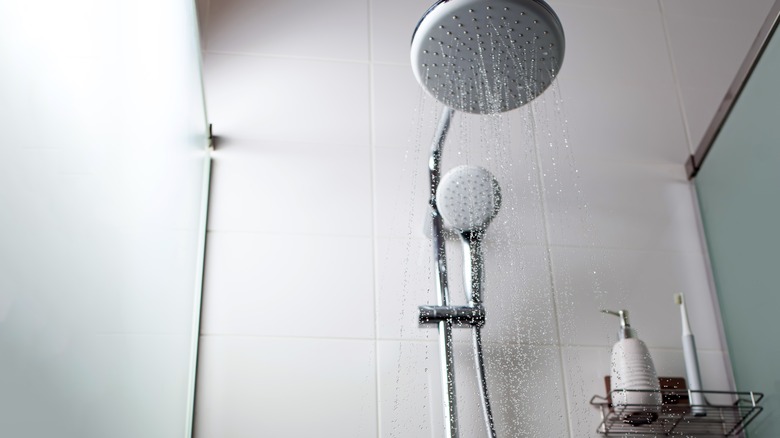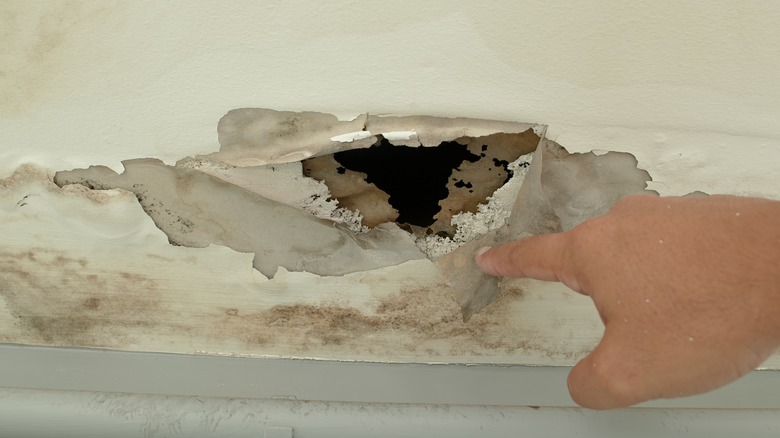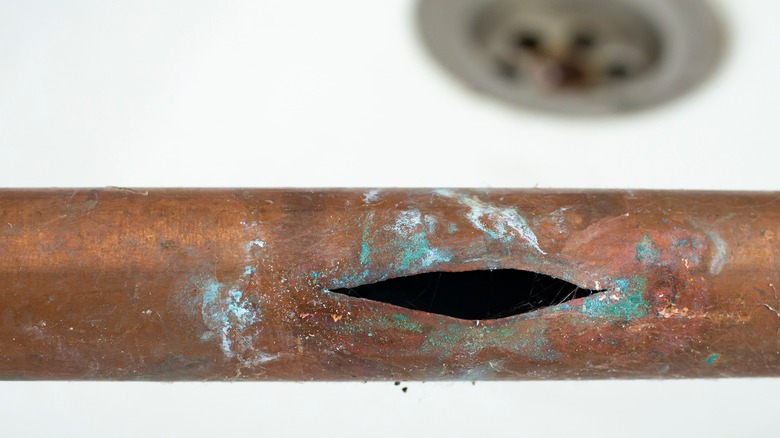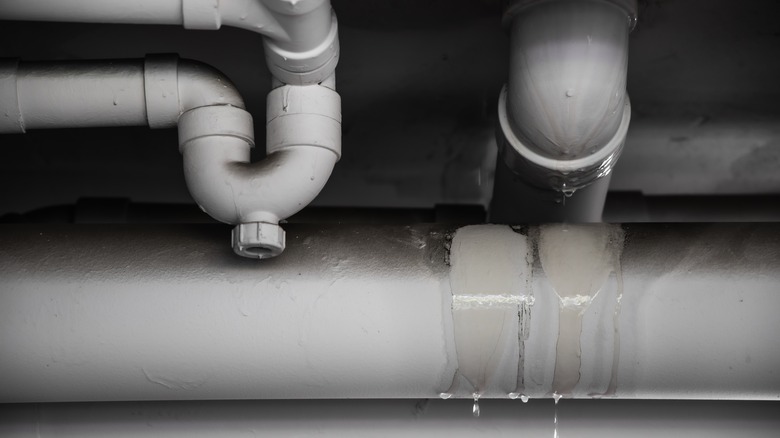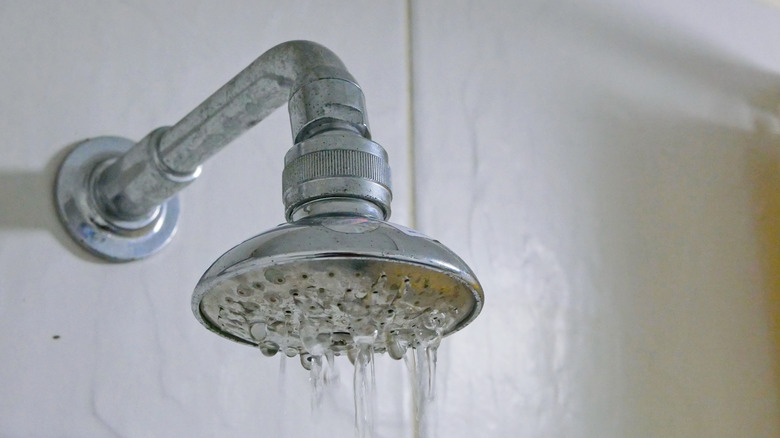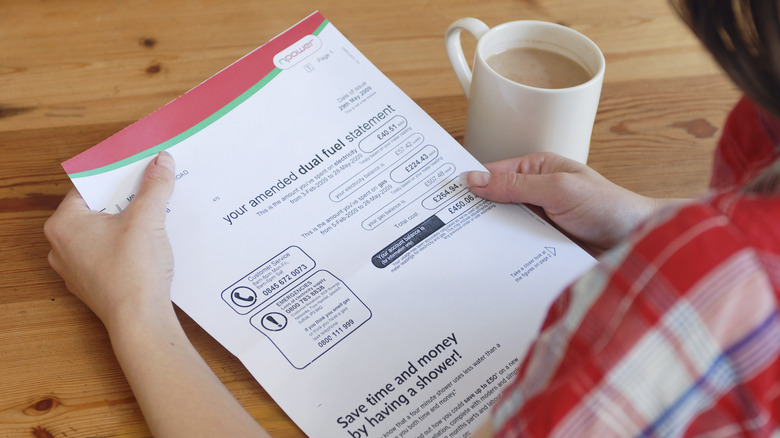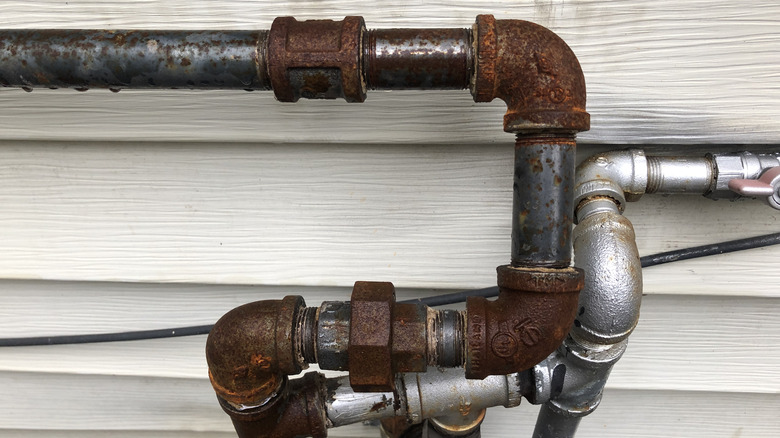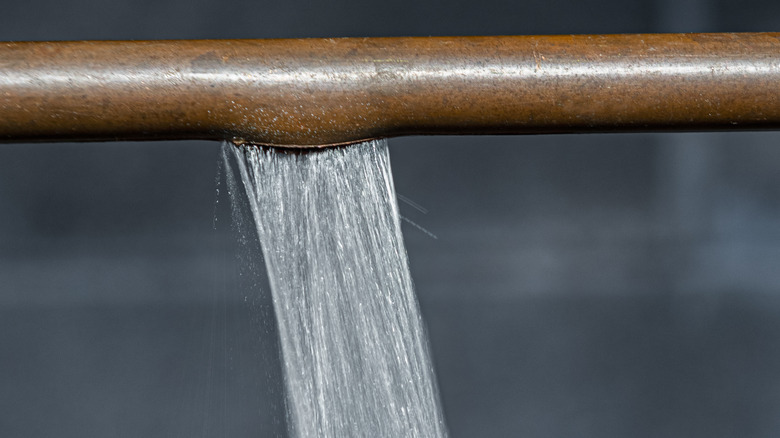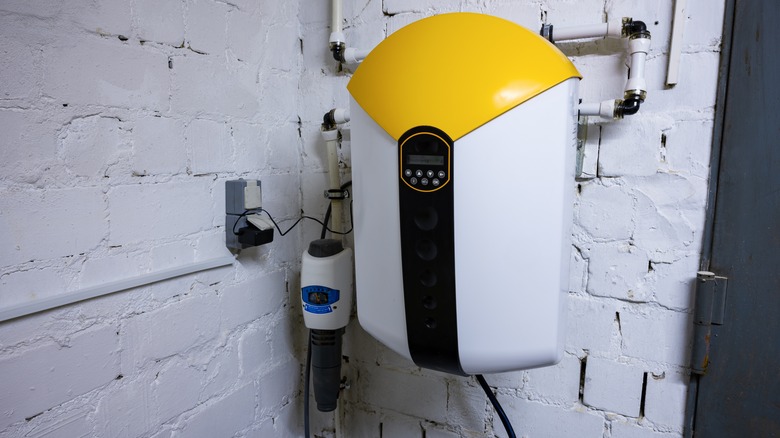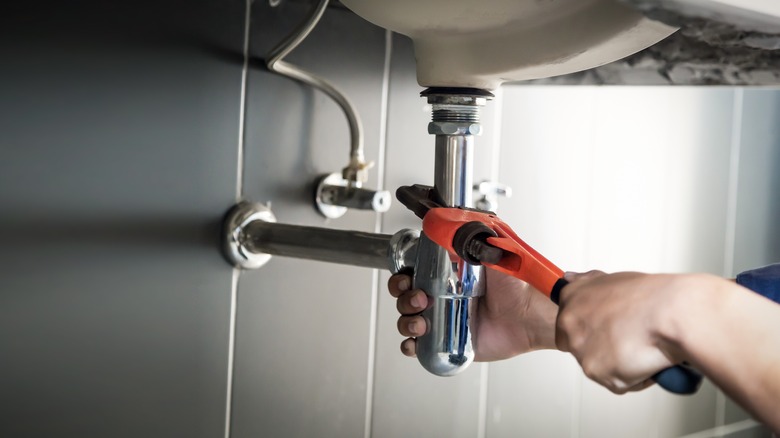Keep Your Water Flowing By Detecting These Signs Of Major Pipeline Cracks Early
We may receive a commission on purchases made from links.
A small crack in your pipe can easily be the biggest home repair disaster you'll ever face. Even the tiniest of fractures, caused by age, rust, or corrosion, can rupture in an instant — leaving you with thousands of dollars in damages. Instead of facing this problem head-on, you can instead keep your water flowing by detecting these signs of major pipeline cracks early. In this House Digest exclusive, we interviewed plumbing professionals Geno Caccia, the CEO of Caccia Plumbing, and Josh Mitchell, a plumbing technician at Plumbing Lab, to discover the best signs to look out for to keep your pipes intact.
They not only reveal what events cause these cracks, but also how to get out ahead of the issue, even when the damage is already quite progressed. By following their advice, you can save yourself the financial and logistical hassle of dealing with the water damage that a burst pipe brings.
Visible damp spots mean some damage has already occurred
Some might think that seeing any sort of water damage on your walls means it's already too late; however, you can still save your home from even more deterioration if you act quickly. "The appearance of damp spots or water stains on walls, ceilings, or floors is one of the most common signs," Caccia shares. "These can be subtle, often resembling small, discolored areas first. These could be mistaken for harmless water marks." If you notice any discoloration, you can save yourself major headaches down the road if you do a careful investigation.
When seen on the floor or ceiling, these marks will often be light brown or gray and have ragged, bumpy edges. Hardwood floors and paint can begin to bubble, before bursting open into a chipped peel. Caccia advises you keep your eyes out for even the smallest of discolorations near where you know pipes are running. If you have access to the pipe, such as under a sink, you can confirm whether or not there is a bigger problem on the way, as "pinhole leaks can be easily spotted by running your hand along the pipe to feel for wetness or by wrapping the pipe in toilet paper."
Searching for visible hairline cracks can save you from a hassle
While most folks won't make a habit of visually inspecting their pipes during their daily clean there are certain times where a task like this can be valuable. For example, after a big freeze when pipes are known to split due to the quick, drastic drops and rises in temperature. Before turning your water on all the way or returning to full use, give your pipes a once-over for any changes, however small. "These often appear as faint, irregular lines on the pipe surface," Mitchell notes. "While subtle, they can widen over time and should be addressed promptly."
If you aren't sure you will be able to tell the difference between a hairline crack or a simple scratch or blemish, consider taking a few photos of your pipes during your pre-storm inspection. This way, you'll have an easy reference for what they looked like before and after any damage occurred. If you find a crack or a leaking pipe in need of repair, you have to take care of it before resuming use of the pipe to avoid major water damage.
Hearing water flowing when you know you shouldn't
One of the easiest ways to pick up on a pipeline crack in its early days is to listen for it. You don't need the hearing of a dolphin to pick up on this warning sign, either — as the bigger the problem, the louder the flow of water will sound...especially when the water is completely off. "Another sign is the sound of flowing water when no taps are open. This could point to a pipeline crack causing a hidden leak," Caccia shares. "Depending on the size of the crack, this can be a subtle trickling or a more pronounced rushing sound."
If you are worried your ears are playing tricks on you, our experts know exactly the sounds to look out for. "A hissing or whistling sound in a pressurized pipeline can indicate a small crack or pinhole leak," Mitchell adds for better understanding. If you still aren't sure, take the time to remove auditory distractions so you can really focus. Things like turning off the TV and unplugging any appliances that might be humming away in the background, etc. so you can hear better.
No or low water pressure means something is amiss
One of the first places you might notice something is wrong with your pipes is in the shower, or while washing your hands in the kitchen. "If you monitor the pipeline's pressure, sudden or unexplained drops might indicate a developing crack," Mitchell says. The reason for this, he asserts, is very simple. If the water has a way to exit the pipe before it's supposed to, the pressure and flow of the liquid in the enclosed space will drop. This makes everything happen a lot slower. "For example, a noticeable decrease from a normal water pressure range of 60-80 psi to something lower can point to a leak somewhere in your system," he continues.
You might not have a problem if you have just one bad shower — but if it's happening for multiple days, or if you can't get the water in the kitchen sink up past a mere trickle, it's time to take action. As a first step, Mitchell recommends checking your water meter to see if the change in pressure is from a leak or not. "First, ensure no water is being used in the house," he says. "Then watch the meter. If it continues to change, there's likely a leak in your system."
An increased water bill isn't a good sign
If your water bill suddenly shoots up but you don't feel like you've been using more water than normal, something is definitely wrong. "Although not a visual sign, an unexplained increase in your water bill is quite obvious evidence of a leak," Caccia shares. "The average household loses about 10,000 gallons of water each year due to leaks, according to the Environmental Protection Agency (EPA)." Because of this, he advises those concerned to pull out bills from not only last month, but the same month in years previous, too.
This is because it's normal for the exact amount you are charged by your water provider to change from month to month, as perhaps the holidays mean more water usage due to out-of-town guests, or the summer due to lots of cold showers. However, if you've noticed that you have used roughly 900 gallons every December for ten years, while this year is suddenly 1,400 — it's worth labeling a leak as the source of your problem. Of course, if no leak is eventually found, be sure to call your water provider to go over your bill with you and address anomalies.
Any discoloration or rusting is a major alarm bell
If your pipes start changing colors, it could be that a major crack is about to break through, but you have the chance to catch it in time. Mitchell warns, "Metal pipes, in particular, may show rust or unusual discoloration where cracks are forming, especially around welded joints or seams." These are the weakest areas in plumbing since it's where two pieces meet. However, while most people might assume that rust is just an indicator of age, it instead indicates that there is persistent moisture present. "Rust occurs when the iron in the metal reacts with oxygen and water, a process known as oxidation. This reaction forms the reddish-brown flaky coating known as rust that weakens the metal."
So if there is a lot of rust on your pipes, new or old, it means that there has been a steady stream of water over a long enough period of time to cause the damage. If not addressed, this constant drip can make pipes weaker, leading to a higher chance of leaks or breaks. To avoid this, "look out for any flaking or pits on the pipe surface, as these are clear signs that rusting is taking place and potentially hiding a leak," Mitchell warns.
Seeing bulging means a pipe is about to crack
If you think that your pipes are taking on a bit of a strange shape, it's possible that they are about to burst. "Small bulges in the pipe could point to internal pressure buildup resulting from a crack," Caccia explains. This can be caused by water pressure that is a little bit too high or a disruption in the flow of the liquid through the pipe because something is stuck. You'll be able to tell this is happening to you because you'll run out of hot water quite quickly, your toilet will always seem like it's running, and you might hear loud, banging noises in your pipes on a regular basis.
To fix this bulging problem before your pipes burst, you'll need to either flush the pipes to clear the blockage or get the water pressure under control. You can do this with a pressure-regulating valve (PRV). PRVs have been required by law to be included in new builds since 2002, so if your home is older than this, it might not have one. However, you can easily buy them at most home retailers, or online places like Amazon, where you can get the Zurn Wilkins PRV for $96.78.
Why ignoring these warning signs can cost you big
Water damage takes absolutely no prisoners. Even the smallest amount of flooding can render a house unlivable for weeks on end. Just six inches of liquid can seep into the electrical sockets, ruin appliances, and write off flooring and furniture. Plus, "water leaking into floors and walls could cause structural damage. Therefore, weakening support beams and compromising the integrity of your home's foundation," Caccia warns. Even a flooded basement might cost more than $4,000 (on average) to totally fix — and the cost only climbs when other areas of the home are impacted and you need to move out while the work is done.
Yet it's not just your home that might be at risk, but it's your health, too. "Mold and mildew thrive in the moist environment created by hidden leaks," Caccia says. "This not only damages your house more but can also pose serious health risks to your family." If anyone has allergies or asthma, even the smallest amount of water damage can cause lots of mold and make them very sick. Ignoring a water leak just isn't worth the risk.
Early prevention tips for pipeline cracks
The best way to prevent water damage to your home is to look after your pipes regularly and well. No problem is ever too small to ignore, as our experts agree that even the tiniest leak can quickly snowball into something major. "Though it seems insignificant, a small drop might point to a larger problem and should never be overlooked," Caccia warns. To get out ahead of leaks, he recommends installing a water softening system in your home, especially if you live somewhere where the water is very hard. Hard water means it has a lot of minerals in it. These systems help to break down those minerals so they don't cause clogs that cause cracks. You can get portable versions of them on Amazon (like this RV water softener for $128.97). If you aren't sure if you have hard water or not, it's easy to test for it.
When installing or fixing up pipes, there are also a number of things you can do with the pipes to slow down corrosion, thus preventing cracks and extending their life. For example, using cathodic protection for metal pipes. "This technique reduces corrosion by using a sacrificial anode, extending the lifespan of metal pipelines," says Mitchell. Plus, if you do feel like swapping things out, Mitchell continues, "opting for pipeline materials like HDPE (High-Density Polyethylene) for new installations reduces the likelihood of cracks as these materials are more resistant to stress and corrosion than traditional metal or PVC."
How often should you inspect your pipes for damage?
You don't need to check your pipes every day to stay on top of any developing cracks. You don't even need to have a look weekly or bi-monthly. Instead, even with a quite conservative approach, you will still be less likely to experience major issues than those who do not check at all. "The frequency of inspections depends on the pipeline's material, age, and purpose," Mitchell advises. "Plastic pipelines should be inspected at least once every 3–5 years. Metal pipelines (especially those subject to corrosion) need more frequent checks—ideally every 1–2 years."
A quick caveat, however is that pipe splitting is way more likely to occur if you're unprepared for a big winter storm. Because of this, you should give your pipes a thorough inspection if you're anticipating a particularly cold winter or are warned of an oncoming storm. If you are doing any sort of renovation to wet spaces, like the kitchen, bathroom, or laundry room, it's also worth having a quick peek at the pipes. Since the drywall is open and the plumbing is exposed, you might as well conduct a thorough inspection.
